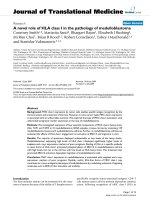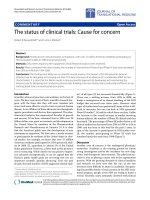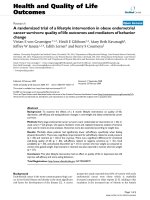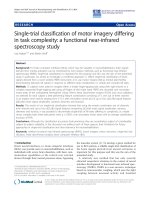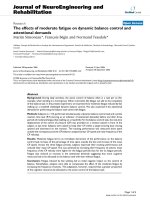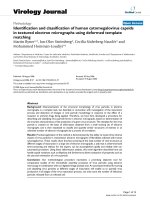báo cáo hóa học:" The clinical significance of the FUS-CREB3L2 translocation in low-grade fibromyxoid sarcoma" pptx
Bạn đang xem bản rút gọn của tài liệu. Xem và tải ngay bản đầy đủ của tài liệu tại đây (653.91 KB, 6 trang )
RESEARCH ARTIC LE Open Access
The clinical significance of the FUS-CREB3L2
translocation in low-grade fibromyxoid sarcoma
Barry Rose
1*
, George S Tamvakopoulos
1
, Kamaljit Dulay
2
, Robin Pollock
1
, John Skinner
1
, Timothy Briggs
1
,
Steven Cannon
1
Abstract
Background: Low-grade fibromyxoid sarcoma (LGFMS) is a rare soft-tissue neoplasm with a deceptively benign
histological appearance. Local recurrences and metastases can manifest many years following excision. The FUS-
CREB3L2 gene translocation, which occurs commonly in LGFMS, may be detected by reverse-transcriptase
polymerase chain reaction (RT-PCR) and fluorescence in situ hybridisation (FISH). We assessed the relationship
between clinical outcome and translocation test result by both methods.
Methods: We report genetic analysis of 23 LGFMS cases and clinical outcomes of 18 patients with mean age of
40.6 years. During follow-up (mean 24.8 months), there were no cases of local recurrence or metastasis. One case
was referred with a third recurrence of a para-spinal tumour previously incorrectly diagnosed as a neurofibroma.
Results: Results showed 50% of cases tested positive for the FUS-CREB3L2 translocation by RT-PCR and 81.8% by
FISH, suggesting FISH is more sensitive than RT-PCR for confirming LGFMS diagnosis. Patients testing positive by
both methods tended to be younger and had larger tumours. Despite this, there was no difference in clinical
outcome seen during short and medium-term follow-up.
Conclusions: RT-PCR and FISH for the FUS-CREB3L2 fusion transcript are useful tools for confirming LGFMS
diagnosis, but have no role in predicting medium-term clinical outcome. Due to the propensity for late recurrence
or metastasis, wide excision is essen tial, and longer-term follow-up is required. This may identify a difference in
long-term clinical outcome between translocation-po sitive and negative patients.
Background
Low-grade fibromyxoid sarcoma (LGFMS) is a rare low-
grade neoplasm first described in 1987 [1]. Its true inci-
dence is unknown . LGFMS most commo nly af fects
young to middle-aged adults, an d has a male: female
ratio of approximately 3:1 [2-4]. Typically LGFMS
occurs in the trunk and proximal extremities, and lies
deep to fascia, although it may occur superficially
[1-3,5]. It usually presents as a painless mass. There
have been case reports o f the tumour arising intra-cra-
nially [6,7], within the thoracic cavity [8] and abdominal
cavity [9].
LGFMS is an indolent tumour with a deceptively
benign histological appearance [1,10]. The diagnosis of
LGFMS by histopathology alone may not be easily
reached because of the bland appearance of the sections,
which can resemble other benign or low-grade fibro-
myxoid lesions [11]. Molecular testing can be used to
aid or confirm the diagnosis. Local recurrences are not
uncommon (≤10%), and the tumour metastasises in
5-10% of cases [5,12]. Despite this, there is good long-
term survival [1]. Treatment is by surgical excisio n.
LGFMS has not bee n found to be chemo- or radio-
sensitive.
The characteristic chromosomal translocation t(7;16)
(q33;p11) results in the balanced FUS-CREB3L2 fusion
gene, which has been shown to be present in most cases
of LGFMS [10,11,13-16]. The translocation t(11,16)(p11;
p11) results in the balanced FUS-CREB3L1 fusion gene,
which is also found in cases of LGFMS, though less fre-
quently [13,14]. Cytogenetic and molecular genetic
approaches can, therefore, be used as a tool for arriving
at a diagnosis of LGFMS [15,17].
* Correspondence:
1
The Royal National Orthopaedic Hospital NHS Trust, The London Bone and
Soft-Tissue Tumour Unit, London, UK
Full list of author information is available at the end of the article
Rose et al . Journal of Orthopaedic Surgery and Research 2011, 6:15
/>© 2011 Rose et al; licensee BioMe d Central Ltd. This is an Open Access article distributed under the terms of the Creative Commons
Attribution License ( which permits unrestricted use, distribution, and reproduction in
any medium, provided the original work is prop erly cited.
The tumour-specific FUS-CREB3L2 fusion gene can be
detected using a reverse-transcription polymerase chain
reaction (RT-PCR) using formalin-fixed paraffin-
embedded tissue [11,18] (the sensitivity using DNA-based
PCR is reported to be lower [18]), and by fluorescence in
situ hybridisation (FISH).
The aim of this paper is to review our series of
patients with LGFMS to assess the relationship between
FUS-CREB3L2 test results using RT-PCR and FISH, and
to assess any correlation these may have with the clini-
cal outcome.
Materials & methods
A retrospective review of our histopathol ogical database
was carried out. All patients with a diagnosis of LGFMS,
as classified by the World Health Organisation, were
included in the study [19]. Our study covered the period
2004-2008.
All patients underwent pre-operative Magnetic Reso-
nance Imaging (MRI), and the diagnosis was reached on
a needle core biopsy which was followed by wide local
excision, or on excision biopsy. Staging was achieved
with a Computed Tomography (CT) scan of the chest
and a technetium-99 bone scan.
Outcome measures included time to local recurrence,
presence/absence of metastases and survival data. All
resection specimens were subjected to conventional ana-
lysis including tumour margins. They were all subjected
to cyto genetic analysis by R T-PCR and FISH. FUS-
CREB3L2 RT-PCR was performed by RNA extraction
(Ambion) from paraffin-embedded tumour blocks. This
was followed by RNA quantification, reverse transcrip-
tion and addition of specific primer (Invitrogen) to
obtain a PCR product. The PCR product was then
visualised on an agrose gel. FISH analysis was performed
using bacterial artificial chromosome (BAC) clones that
were selected according to their location (chromosomes
7 and 16) with regard to the genes involved in the FUS-
CREB3L2 translocation. The clone s were prepared , pro-
cessed, labelled and analysed for fluorescent signals
according to standard procedures. T he presence or
absence of the FUS-CREB3L2 translocation by both
methods was noted.
Histopathological analysis and clinical outcomes for
all identified cases of LGFMS were compared to res ults
of FUS-CREB3L2 translocation PCR and FISH testing
and subjected to statistical analysis using the Student’s
T test.
Results
Twenty-three tumours were identified in 23 patients.
Five cases consisted of slides referred from other units
for our specialist opinion. There were 10 male and
13 femal e patients. The mean age was 40.6 years (range
14-70 years). Ten tumours (43.5%) were located in the
lower limb, 5 (21.7%) in the upper limb, and 7 (30.4%)
were related to the trunk, and the location of 1 tumour
(4.3%) was not specified. The history of symptom dura-
tion was available in 14 patients, with a mean o f 33.3
months (range 3-300 months).
All 5 referred cases were resection specimens. Of the
18 cases from our institution, 14 had a pre-operative
core needle biopsy (77.8%), and 4 went straight on to
excision biopsy (22.2%). All 18 of these patients were
treated definitively with surgical excision. In all cases
that were biopsied, LGFMS was correctly diagnosed by
histopathological examination prior to resection.
Excision was wide in 6 resection cases (33.3%) and
marginal in 12 cases (66.7%). Marginally excised cases
all had a 1 mm mar gin of normal tissue. There were no
cases of intra-lesional excision. The mean maximum
diameter of the resected tumours was 84.3 mm (range
20-150 mm).
Three patients were lost to follow-up. Mean follow-up
of the remaining 15 cases was 24.8 months following
surgical excision (range 6 to 53 months). One case was
referred as recurrence of a para-spinal neurofibroma
that had previously been resected 9 years and subse-
quently 5 years prior to referral. Biopsy histology from
the lesion suggested a malignant peripheral nerve sheath
tumour, but histology from our resection revealed a
LGFMS. She underwent subsequent radiotherapy, and
has had no further recurrence. No other patients
received chemotherapy or radiotherapy at any point.
Apart from the above patient there were no cases of
local recurrence. There were no cases of metastasis.
The histopathological diagnosis of the specimens,
which were all undertaken by the senior Pathologist,
was based on the light microscopic features. Histopatho-
logical examination revealed the classi cal features of
LGFMS, which include a mixture of heavily collagenised
zones and more cellular myxoid nodules. The tumour
cells are classi cally spindle shaped and bland with occa-
sionally scattered hyperchromatic cells and very scarce
mitoses. Approximately 40% of LGFMS show focal
poorly formed collagen rosettes which consist of a cen-
tral core of hyalinized collagen surrounded by epithe-
lioid fibroblasts [1] (Figure 1, Figure 2, Figure 3).
Specimens from a total of 21 patients underwent
RT-PCR testing and 22 patients underwent FISH testing
for the FUS-CREB3L2 translocation. Testing was per-
formed solely on biopsy specimens in 8 patients (34.8%),
solely on resection specimens in 10 patients (43.5%),
and on both biopsy and resect ion specimens in 3
patients (8.7%).
RT-PCR testing was not performed on 2 specimens,
and the RNA was inadequate for testing on 3 specimens.
Tumours from 9 patients tested posit ively for the
Rose et al . Journal of Orthopaedic Surgery and Research 2011, 6:15
/>Page 2 of 6
FUS-CREB3L2 transcript (50%) by RT-PCR, 2 tests were
equivocal (11.1%), and 7 were negative (38.9%). Results
are displayed in table 1.
The mean age of patients whose samples tested positive
by RT-PCR was 34.0 years (range 14-52 years) compared
to 47.1 years (range 24-70 years) for those testing nega-
tive (p = 0.10). Within the positive group, 5 tumours
(55.6%) were located in the low er limbs, with 3 tumours
(33.3%) in the trunk and 1 tumour (11.1%) in the upper
limb. Within the group testing negative, 3 of the tumours
(42.9%) were located in the upper limbs, compared to 2
(28.6%) in the trunk and 2 (28.6%) in the lower limbs.
The mean maximum diameter for positive samples was
99.7 mm (range 30-150 mm), compared to 64.1 mm
(range 20-130 mm) for those testing negative (p = 0.18).
FISH testing was not performed on 1 specimen.
Eighteen patients tested FU S-CREB3L2 translocation
positive (81.8%) and 4 were negative (18.2%). The mean
age of patients whose samples tested positive by FISH
was 37.7 years (range 10-67 years) compared to 51.0
years (range 31-70 years) for those testing negative (p =
0.21). Within the positive-testing group, 9 tumours
(50%) were located in the lower limbs, with 6 tumours
(33.3%) in the trunk, 2 tumours (11.1%) in the upper
limbs and 1 tumour location unspecified (5.6%). Within
the group testing negative, 3 of the tumours (75%) were
located in the upper limbs and 1 (25%) in the lower
limbs. The mean maximum diameter for positive sam-
ples was 89.4 mm (range 30-150 mm), compared to
66.3 mm (range 20-130 mm) for those testing negative
(p = 0.44).
Three specimens tested negati ve by both RT -PCR and
FISH. All of these specimens were further reviewed by
the senior Pathologist to ensure that the histopatholo gi-
cal diagnosis of LGFMS was correct.
Figure 1 Macroscopic appearances of a low grade fibromyxoid
sarcoma tumour.
Figure 2 Microscopic appearances of a low grade fibromyxoid
sarcoma tumour (H&E stain, 40X magnification).
Figure 3 Microscopic appearances of a low grade fibromyxoid
sarcoma tumour (H&E stain, 100X magnification).
Rose et al . Journal of Orthopaedic Surgery and Research 2011, 6:15
/>Page 3 of 6
Discussion
Low-grade fibromyxoid sarcoma is a rare soft tissue
neoplasm first described as a separate pathological entity
by Evans in 1987 [1]. Its true incidence is unknown.
Patients tend to be young to middle-aged adults. Evan’s
original series of 12 patients [5] reported ages ranging
from 6 to 51 years, w ith all but three between 26 and
46 years of age. Further studies report mean ages of 38
years [13], 29 years [3], and 39 years (range 28 to
44 years) [4], and a median age of 34 years [12], and 45
years [2]. Our mean age of 40.6 years is comparable
with these series. Our male: female ratio was 1:1.3 (10
male and 13 female patients). This is similar to the ser-
ies reported by Guillou et al. [13] (22 male, 26 female).
Folpeetal.[12]describeamalepredominance(40
male, 33 female), as do the smaller series of Billings et
al., Goodlad et al. and Zamecnik and Michal [2-4].
The largest series of LGFMS [12] report s 37 tumo urs
located in the lower limb (including buttock and gr oin),
25 related to the trunk, head and neck, and 11 in the
upper limb (incl uding axilla). Guillou et al. [13 ] describe
a ratio of 23:23:2, and combining othe r smaller pub-
lished series [2-5] reveals a ratio of 25:17:7. Our series
also shows the most common tumour location to be the
lower limb, at a comparable ratio of 2:1.4:1.
The mean diameter of tumours reported by Billings
et al. was 42 mm (range 16-160 mm) [3], with a median
diameter reported as 45 mm (range 10-230 mm) b y
Folpe et al. [12], and 95 mm (range 35-150 mm) by
Evans [5]. O ur mean diameter was larger at 84.3 mm,
but with a comparable median (87.5 mm) and range
(20-150 mm).
We cannot account for the patients lost to follow-up.
One patient was referred with a third recurrence of a
para-spinal tumour, previously diagnosed as a neurofi-
broma. Our resection specimen showed the tumour to
be a LGFMS. In retrospect, it is likely that this was a
recurrence of a previously incorrectly-diagnosed
LGFMS. When misdiagnosed, LGFMS is most com-
monly reported as a benign lesion, either a neurofi-
broma or a perineurioma. This may result in inadequate
resection, thus increasing the chance of recurrence or
metastasi s. The tumour was excised with marginal mar-
gins, and the patient had post-operative radiotherapy.
She has had no metastases to date, which represents
14 years following the original tumour resection.
In our series of patients in whom follow-up was
achieved, no instances of local recurrence or metastasis
occurred during the follow-up period, even though 12
patients (66.7%) had a marginal resection. This is sub-
stantially lower than o ther series, although we accept
that our follow-up is medium-term. In their large series,
Folpe et al. [12] report a local recurrence rate of 9%,
metastasis rate of 6%, and 1% of cases dying of LGFMS
at a mean of 38 months and median of 24 months fol-
low-up. Guillou et al. [13] report a smaller series than
Folpe, but with substantially longer follow-up. Their
recurrence rate and metastasis rate were both 21% for
those cases presenting with only local disease, with an
overall metastasis rate of 27%. These are all significantly
greater than the series reported by Folpe et al. Guillou
et al reported over a much longer follow-up period,
with the median times to local recurrence and metasta-
sis being 276 months and 132 months respectively, and
83% of the cases of metastasis occurring b eyond nine
years follow-up. Billings et al. [3] followed 16 patients,
experiencing 2 episodes of local recurrence (5 and
16months),butnometastases.Goodladetal.[2]
reported a median follow-up o f 6 years for 11 patients,
experiencing 6 episodes of local recurrence and 1
patient with pulmonary metastases.
In our series the width of excision margin has had no
impact on outcome to date, although Guillou et al.
report that all their cases of local recurrence occurred
following incomplete or marginal tumour excision [13].
Reaching the diagnosis of LGFMS can be difficult due
to its bland-looking histological features. The differential
diagnosis includes other benign or low-grade fibromyx-
oid lesions, including low- grade myxofibrosarcoma,
myxoid neurofibroma, perineuroma, myxoid solitary
fibrous tumour and desmoid fibromato sis [13,17].
Immunohistochemistry has p roduced some c onflicting
reports [17], and is therefore unreliable for confirming a
diagnosis.
Cytogenetic and molecular genetic analyses have
shown that many types of soft tissue sarcoma are char-
acterised by specific chromosomal translocations result-
ing in ‘ chimeric fusion genes’ ,whichresultinthe
Table 1 Comparison of FUS-CREB3L2 results
Location (%)
FUS-CREB3L2 Test Result Number (%) Mean Age M:F Ratio Mean Maximum Diameter (mm) UL LL Trunk
RT-PCR Positive 50.0 34.0 2:1 99.7 11.1 55.6 33.3
RT-PCR Negative 38.9 47.1 1:2.5 64.1 42.9 28.6 28.6
FISH Positive 81.8 37.7 1:1.6 89.4 11.1 50 33.3
FISH Negative 18.2 51.0 1:1 66.3 75 25 0
M:F, Male: Female; UL, Upper Limb; LL, Lower Limb.
Rose et al . Journal of Orthopaedic Surgery and Research 2011, 6:15
/>Page 4 of 6
production of chimeric transcription factors [16]. The
FUS gene has been shown to be rearranged in a variety
of neoplast ic conditions, including myxoid liposarcoma,
angiomatoid fibrous histiocytoma and acute myeloid
leukaemia [16].
LGFMS was first characterised at a genetic level by
Storlazzi et al. [16], who described 2 cases of a chromo-
somal translocation t(7;16)(q33;p11), which fuses t he
FUS gene to BBF2H7 (also known as CREB3L2). Pana-
gopoulos et al. [15] subsequently suggested that the
FUS-CREB3L2 translocation is specifically associated
with LGFMS. They tested 59 tu mours not previously
identified as LGFMS for the FUS-CREB3L2 transloca-
tion. This test produced 12 positive specimens, all of
which, upon histopatholgic re-examination, were diag-
nosed as LGFMS. In contrast however, Guillou et al.
report that 7 out of 52 (13.5%) of their FUS-CREB3L2
fusion gene positive cases occurred in non-LGFMS neo-
plasms, of which 4 were diagnosed as sclerosing epithe-
lioid fibrosarcoma [13]. This tumour may, in some
instances, represent a morphologic variant of LGFMS,
rather than a distinct entity in itself.
Guillou et al. report that 45 out of 59 LGFMS cases
(76.3%) were positive for FUS-CREB3L2 [13]. Mat-
suyuma et al. report the identification of the FUS-
CREB3L2 fusion gene in 88% of their LGFMS c ases
[11]. Their series identified the fusion gene solely in
cases of LGFMS. Mertens et al. report this figure to be
96% in their series, and furthermore state that no other
tumours were fusion-positive [ 14]. Our series produced
a far lower number of positive tests by RT-PCR (50%),
but a comparable number by FISH (81.8%). This would
suggest that FISH testing is substantially more sensitive
at detecting LGFMS than RT-PCR. Guillou et al. suggest
that fusion-positive LGFMS have predominance in lower
extremities (22/48 cases, 45.8%), which is in accordance
with the 55.6% of RT-PCR positive cases and 50% FISH
positive cases seen in our series [13].
We compared the clinical outcomes for those pa tients
testing posit ive and negative for the FUS-CREB3L2
translocation using both RT-PCR and FISH. Despite not
being statistically significant, negative-testing specimens
occurred in older patients (47.1 years, as compar ed to
34.0 years for RT-PCR positive patients; 51.0 years, as
compared to 37.7 years for FISH positive patients), and
tended to be smaller (mean diameter 64.1 mm, as com-
pared to 99.7 mm for RT-PCR positive patients;
66.3 mm, as compared to 89.4 mm for FISH positive
patients). As the follow-up of our series revealed no
patients with recurrence or metastasis, it is not possible
to extrapolate as to w hether a positive or negative test
result for the FUS-CREB3L2 translocation has a bearing,
or could be used as a predictive factor, for future patient
morbidity or mortality. The tumour from the pat ient
presenting with a third recurrence (previously incor-
rectly diagnosed as neurofibroma) tested positive by
FISH. RT-PCR was not performed on this specimen.
The proteins encoded by CREB3L1 and CREB3L2
belong to the same family of transcription factors [14].
One study suggests that the CREB3L2 transcription fac-
tor is both functionally and structurally similar to the
CREB3L1 transcription factor [20]. Therefore it is not
surprising to find positive tests in cases of LGFMS for
the FUS-CREB3L1 fusion-gene in the literature. The
remaining case (4%) not testing positive for FUS-
CREB3L2 in the series described by Mertens et al. tested
positive for the FUS-CREB3L1 tran slocation, as did 3
cases (5.1%) in the series by Guillou et al. [13,14]. Our
study did not test for the FUS-CREB3L1 translocation.
Conclusion
In our series, the proportion of cases of LGFMS testing
positive for the FUS-CREB3L2 tran slocation by RT-PCR
is lower than previously described, but the proportion
testing positive by FISH is comparable. Our results con-
cur with previous data suggesting that the FUS-
CREB3L2 fusion-gene is a specific marker for LGFMS.
FISH testing is a more sensitive method of confirming a
diagnosis of LGFMS.
Although not statistically significant, our series indi-
cates that those tumours testing positive by RT-PCR or
FISH tend to occur in younger patients and be larger in
size. P atients followed-up in our series had no episodes
of recurrence or metastasis post-operatively, although
we identified one case where the tumour had previously
been incorrectly diagnosed, and had subsequently
recurred twice. The clinical outcome for both positive
and negative-testing cases of LGFMS appears to be the
same at medium-term follow-up. However, longer-term
follow-up is required to elucidate whether the previously
reported rates of late recurrence and metastasis are a
true reflection of the biological nature of this tumour in
our series, and may identify a difference in the long-
term clinical outcome between t ranslocation-positive
and negative patients.
Our results suggest that with adequate surgery, local
recurrence or metastasis is unlikely to occur in the
short-term. Our medium-term results would theoreti-
cally suggest that it is not necessary to perform wide
excision. However, due to the wel l-report ed propensity
for late recurrence or metastasis of LGFMS, we con-
clude that a wide excision is essential if surgically
possible.
We conclude therefore that RT-PCR and FISH analy-
sis for the FUS-CREB3L2 gene rear rangement are useful
tools for confirming the diagnosis of LGFMS, but have
Rose et al . Journal of Orthopaedic Surgery and Research 2011, 6:15
/>Page 5 of 6
no role in predicting the c linical outcome in the short
and medium-term for such cases.
Author details
1
The Royal National Orthopaedic Hospital NHS Trust, The London Bone and
Soft-Tissue Tumour Unit, London, UK.
2
The Royal National Orthopaedic
Hospital NHS Trust, Department of Histopathology, London, UK.
Authors’ contributions
BR and GT wrote, edited and revised the article. KD provided the
pathological advice necessary for the paper. RP, JS, TB and SC provided the
patients for the study and approved the final draft. All authors read and
approved the final manuscript.
Competing interests
The authors declare that they have no competing interests.
Received: 4 January 2010 Accepted: 15 March 2011
Published: 15 March 2011
References
1. Evans HL: Low-grade fibromyxoid sarcoma: a report of two metastasizing
neoplasms having a deceptively benign appearance. Am J Clinical
Pathology 1987, 88:615-619.
2. Goodlad JR, Mentzel T, Fletcher CD: Low grade fibromyxoid sarcoma:
clinicopathological analysis of eleven new cases in support of a distinct
entity. Histopathology 1995, 26(3):229-37.
3. Billings SD, Giblen G, Fanburg-Smith JC: Superficial low-grade fibromyxoid
sarcoma (Evans tumor): a clinicopathologic analysis of 19 cases with a
unique observation in the pediatric population. Am J Surg Pathol 2005,
29(2):204-10.
4. Zámecník M, Michal M: Low-grade fibromyxoid sarcoma: a report of eight
cases with histologic, immunohistochemical, and ultrastructural study.
Ann Diagn Pathol 2000, 4(4):207-17.
5. Evans HL: Low-grade fibromyxoid sarcoma. A report of 12 cases. Am J
Surg Pathol 1993, 17(6):595-600.
6. Saito R, Kumabe T, Watanabe M, Jokura H, Shibuya M, Nakazato Y,
Tominaga T: Low-grade fibromyxoid sarcoma of intracranial origin. J
Neurosurg 2008, 108(4):798-802.
7. Tun K, Ozen O, Kaptanoglu E, et al: Primary intracranial low-grade
fibromyxoid sarcoma (Evans tumor). J Clin Neurosci 2008, 15(11):1298-301.
8. Jakowski JD, Wakely PE Jr: Primary intrathoracic low-grade fibromyxoid
sarcoma. Hum Pathol 2008, 39(4):623-8.
9. Park IJ, Kim HC, Yu CS, Kim JS, Jang SJ, Kim JC: Low-grade fibromyxoid
sarcoma of the colon. Dig Liver Dis 2007, 39(3):274-7.
10. Reid R, de Silva MV, Paterson L, Ryan E, Fisher C: Low-grade fibromyxoid
sarcoma and hyalinizing spindle cell tumor with giant rosettes share a
common t(7;16)(q34;p11) translocation. Am J Surg Pathol 2003,
27(9):1229-36.
11. Matsuyama A, Hisaoka M, Shimajiri S, Hayashi T, Imamura T, Ishida T,
Fukunaga M, Fukuhara T, Minato H, Nakajima T, Yonezawa S, Kuroda M,
Yamasaki F, Toyoshima S, Hashimoto H: Molecular detection of FUS-
CREB3L2 fusion transcripts in low-grade fibromyxoid sarcoma using
formalin-fixed, paraffin-embedded tissue specimens. Am J Surg Pathol
2006, 30(9):1077-84.
12. Folpe AL, Lane KL, Paull G, Weiss SW: Low-grade fibromyxoid sarcoma
and hyalinizing spindle cell tumor with giant rosettes: a
clinicopathologic study of 73 cases supporting their identity and
assessing the impact of high-grade areas. Am J Surg Pathol 2000,
24:1353-1360.
13. Guillou L, Benhattar J, Gengler C, Gallagher G, Ranchère-Vince D, Collin F,
Terrier P, Terrier-Lacombe MJ, Leroux A, Marquès B, Aubain Somerhausen
Nde S, Keslair F, Pedeutour F, Coindre JM: Translocation-positive low-
grade fibromyxoid sarcoma: clinicopathologic and molecular analysis of
a series expanding the morphologic spectrum and suggesting potential
relationship to sclerosing epithelioid fibrosarcoma: a study from the
French Sarcoma Group. Am J Surg Pathol 2007, 31(9)
:1387-402.
14. Mertens F, Fletcher CD, Antonescu CR, Coindre JM, Colecchia M,
Domanski HA, Downs-Kelly E, Fisher C, Goldblum JR, Guillou L, Reid R,
Rosai J, Sciot R, Mandahl N, Panagopoulos I: Clinicopathologic and
molecular genetic characterization of low-grade fibromyxoid sarcoma,
and cloning of a novel FUS/CREB3L1 fusion gene. Lab Invest 2005,
85(3):408-15.
15. Panagopoulos I, Storlazzi CT, Fletcher CD, Fletcher JA, Nascimento A,
Domanski HA, Wejde J, Brosjö O, Rydholm A, Isaksson M, Mandahl N,
Mertens F: The chimeric FUS/CREB3l2 gene is specific for low-grade
fibromyxoid sarcoma. Genes Chromosomes Cancer 2004, 40(3):218-28.
16. Storlazzi CT, Mertens F, Nascimento A, Isaksson M, Wejde J, Brosjo O,
Mandahl N, Panagopoulos I: Fusion of the FUS and BBF2H7 genes in low
grade fibromyxoid sarcoma. Hum Mol Genet 2003, 12(18):2349-58.
17. Vernon SE, Bejarano PA: Low-grade fibromyxoid sarcoma: a brief review.
Arch Pathol Lab Med 2006, 130(9):1358-60.
18. Matsuyama A, Hisaoka M, Shimajiri S, Hashimoto H: DNA-based
polymerase chain reaction for detecting FUS-CREB3L2 in low-grade
fibromyxoid sarcoma using formalin-fixed, paraffin-embedded tissue
specimens. Diagn Mol Pathol 2008, 17(4):237-40.
19. Folpe A, van den Berg E, Molenaar WM: Low grade fibromyxoid sarcoma.
In World Health Organization Classification of Tumours. Pathology and
Genetics of Tumours of Soft Tissue and Bone. Edited by: Fletcher CDM, Unni
KK, Mertens F. IARC Press: Lyon; 2002:104-5.
20. Panagopoulos I, Möller E, Dahlén A, Dahlén A, Isaksson M, Mandahl N,
Vlamis-Gardikas A, Mertens F: Characterization of the native CREB3L2
transcription factor and the FUS/CREB3L2 chimera. Genes Chromosomes
Cancer 2007, 46(2):181-91.
doi:10.1186/1749-799X-6-15
Cite this article as: Rose et al.: The clinical significance of the FUS-
CREB3L2 translocation in low-grade fibromyxoid sarcoma. Journal of
Orthopaedic Surgery and Research 2011 6:15.
Submit your next manuscript to BioMed Central
and take full advantage of:
• Convenient online submission
• Thorough peer review
• No space constraints or color figure charges
• Immediate publication on acceptance
• Inclusion in PubMed, CAS, Scopus and Google Scholar
• Research which is freely available for redistribution
Submit your manuscript at
www.biomedcentral.com/submit
Rose et al . Journal of Orthopaedic Surgery and Research 2011, 6:15
/>Page 6 of 6

